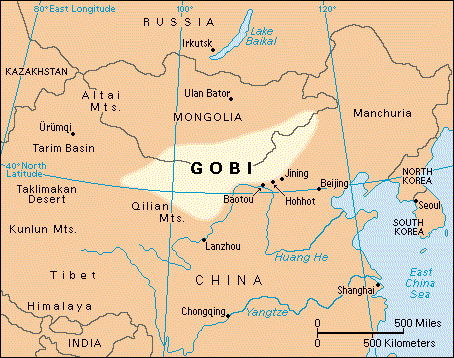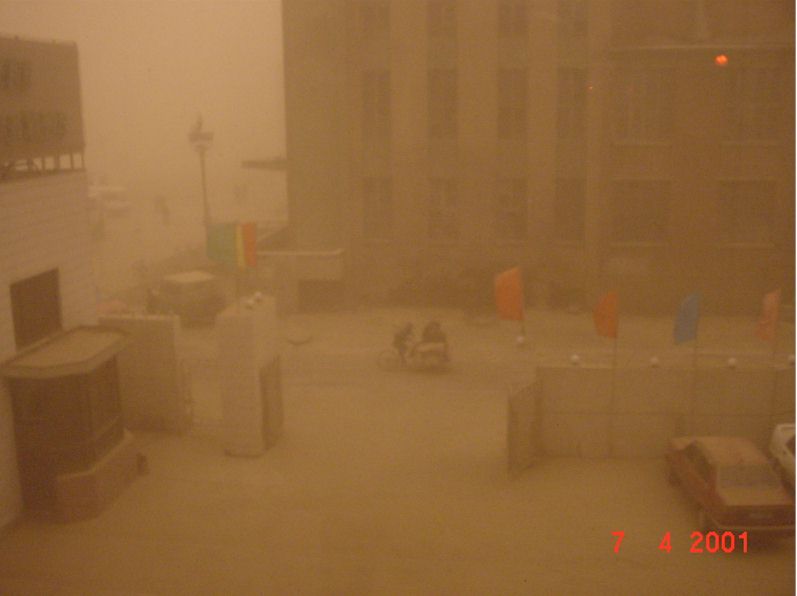| View previous topic :: View next topic |
| What do you call it? |
| yellow dust |
|
69% |
[ 9 ] |
| yellow sand |
|
0% |
[ 0 ] |
| both |
|
23% |
[ 3 ] |
| neither |
|
0% |
[ 0 ] |
| I fart on your poll |
|
7% |
[ 1 ] |
|
| Total Votes : 13 |
|
| Author |
Message |
manlyboy

Joined: 01 Aug 2004
Location: Darwin, Northern Territory, Australia
|
 Posted: Tue Mar 27, 2007 11:29 pm Post subject: Yellow Dust or Yellow Sand? Posted: Tue Mar 27, 2007 11:29 pm Post subject: Yellow Dust or Yellow Sand? |
 |
|
| I'm noticing more and more people refer to it as yellow "sand". Did I miss a meeting? How can the air be "sandy"? Unless you're somewhere like the Sahara, that just sounds wrong to me. |
|
| Back to top |
|
 |
schwa
Joined: 18 Jan 2003
Location: Yap
|
 Posted: Wed Mar 28, 2007 12:17 am Post subject: Posted: Wed Mar 28, 2007 12:17 am Post subject: |
 |
|
| Both are used & accepted. If you google "yellow sand korea" & "yellow dust korea" ("korea" narrows the search some) its nearly a tie, with "sand" slightly ahead. I teach both to my students. |
|
| Back to top |
|
 |
Guri Guy

Joined: 07 Sep 2003
Location: Bamboo Island
|
 Posted: Wed Mar 28, 2007 1:11 am Post subject: Posted: Wed Mar 28, 2007 1:11 am Post subject: |
 |
|
I've always heard Yellow Dust. I've never heard Yellow Sand.
The sand/dust comes from the Gobi Desert in China. |
|
| Back to top |
|
 |
chevro1et

Joined: 01 Feb 2007
Location: Busan, ROK
|
 Posted: Wed Mar 28, 2007 5:58 am Post subject: Posted: Wed Mar 28, 2007 5:58 am Post subject: |
 |
|
From a thread in the Off Topic post (can't figure out how to quote myself :S)
| Quote: |
Posted: Tue Mar 27, 2007 6:36 pm Post subject:
--------------------------------------------------------------------------------
The yellow dust is not carcinogenic or pollution-based in origin. It is a fine eolian sediment commonly known (in Geographical terms) as 'loess'.
General Geological/ Geographical definition:
http://www.answers.com/topic/loess
Loess in Korea:
http://www.a-a-r-s.org/acrs/proceeding/ACRS2006/Papers/P-1_P26.pdf
And yes, I am a science geek and hold a B.Sc. in Geography |
|
|
| Back to top |
|
 |
Pak Yu Man

Joined: 02 Jun 2005
Location: The Ida galaxy
|
 Posted: Wed Mar 28, 2007 6:45 am Post subject: Posted: Wed Mar 28, 2007 6:45 am Post subject: |
 |
|
Sand is a small particle that ranges from 1/16th of a mm to 2 mm in size.
Sand is a soil particle. Sand can not be carried 10s or 100s of km by wind.
Dust is an aerosol (airborn particle).
Sand is on the ground. Calling it sand is wrong.
First time I've used geology/phys geo in 8 years. |
|
| Back to top |
|
 |
Guri Guy

Joined: 07 Sep 2003
Location: Bamboo Island
|
 Posted: Wed Mar 28, 2007 7:09 am Post subject: Posted: Wed Mar 28, 2007 7:09 am Post subject: |
 |
|

Springtime weather in Asia produces intense wind storm events that can pass over the Gobi Desert along the northern China / Mongolia border and other parts of desert China. These winds are capable of generating huge yellow clouds of suspended dust which based on the direction of the prevailing wind can be sent out to sea.
Recent advances in satellite imagery allow the tracking and documentation of these huge Asian aerosol clouds. Sometimes these dust storms are so immense that they can complete a 5-7 day journey across the Pacific Ocean to impact North America.
Strong spring weather systems are capable of generating wind speeds of 60 mph which can last for days across the high steppe desert country of Mongolia and western China. Part of the reason these dust storms are so severe, is that the soil is so loose and fine. To quote Sven Hedin�s account Of the Takla-makan desert in 1895,
"...crossing a dead-flat plain of yellow-grey dust�nothing but dust, so fine that it blew like powder at every breath of the wind, and so soft and deep that driving over it was like an adventure on a feather-bed. The wheels of their wagons were almost sucked into it, the horses labored endlessly; the men, walking alongside, saw their feet sink into the dust ankle-deep with every step. The tracks they left behind were nothing but lines of dimples in the dust. The dust got into everything, the men and horses and every wagon became plastered with greyish-yellow dust."
These fine wind blown duststorms in China commonly referred to as "dust floatings".

Baicheng (Beijing) Dust Storm - April 7, 2001

Interesting Facts
* Wind blown dust originating from the arid deserts of Mongolia and China is a well-known springtime meteorological phenomenon throughout East Asia. In fact, "yellow sand" meteorological conditions are sufficiently common to have acquired local names: Huangsha in China, Whangsa in Korea, and Kosa in Japan.
* Suspended clouds of Asian dust can move across the Pacific in elevated layers (3-11 km agl) and can reach the U.S. in as little as 4-6 days.
* The dust clouds finally dissipate when the particles are removed from the atmosphere by dry and wet removal processes. Gravitational settling of large particles (>10 m m) occurs near the source within the first day of transport. Wet removal occurs sporadically throughout the 5-10 day lifetime of the remaining smaller size dust particles.
* Dust from large deserts that is transported in this manner can be a vital nutrient source for both the oceans and terrestrial ecosystems. Iron in the minerals composing this desert dust will be a vital nutrient in oceanic regions that are deficient in iron. Furthermore, research has shown that the canopy (top layers) of much of the Central and South America rain forest derives much of its nutrient supply from dust that is transported over the Atlantic from the Sahara Desert in northern Africa. Saharan dust occasionally reaches the state of Florida, causing a characteristic high-altitude haziness that obscures the Sun.
October 2000 Report - Chinese Monthly, the Internet
Beijing has always been violently invaded and attacked by air- borne sand and dust, so whenever a windstorm occurs sand and dust fill the sky. There are times when it continues for several days and the ground is then completely covered with a thick layer of sand. Under such weather conditions people have to remain indoors as much as possible, and if you risk going outdoors you have to take care not to be hit by the trees, the store signs, etc. that are being blown down by the wind, and moreover you have to wear a protective mask or veil. Since the sand can readily enter the eyes and mouth, the respiratory systems and eyes of many people are infected in this manner. In addition to the fact that sandstorms cause such inconvenience in people�s lives, they also influence agricultural production, transportation and shipping, and other industries, and cause serious economic damage thereby.
A report by the Chinese Academy of Science has indicated that this sand comes from the degraded pastureland and dry land of the area around the deserts of Inner Mongolia. Records show that during the 17th century there were from 0.3 to 1.0 sandstorms in Inner Mongolia per year, but by 1990 the annual rate of occurrence had risen to 3.0 to 5.0 times per year. At the same time, the rate of occurrence of sandstorms in Beijing has also increased, and the number of violent sandstorms that occurred this spring in Beijing was more than three times the average for the same period in the 1990s. Some have called the sandstorm that occurred on April 10, 2000 the most serious such storm in 10 years. Other than natural factors like aridity being the cause creating such conditions, the fact that China�s ecological environment has suffered damage is also a major source of this calamity.
http://www.lakepowell.net/asiandust.htm
Interesting reading anyway. So classifying Yellow dust as sand is incorrect.
It really is loose soil particulate. |
|
| Back to top |
|
 |
|

